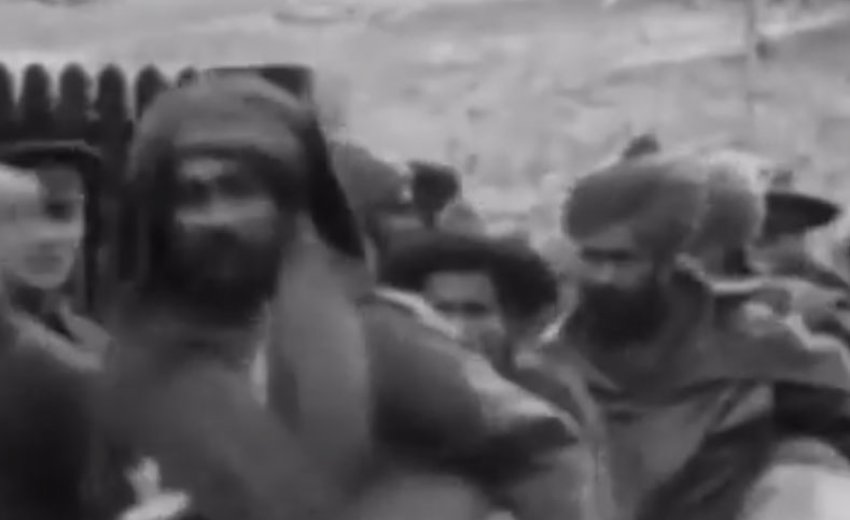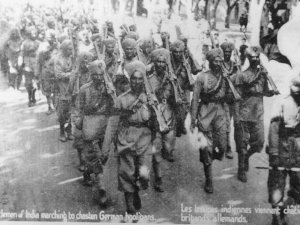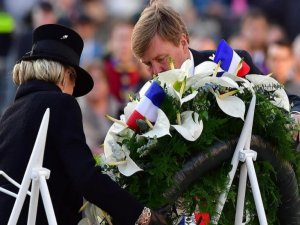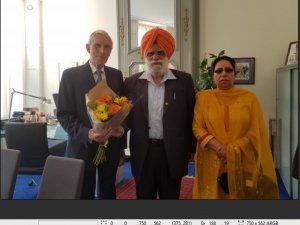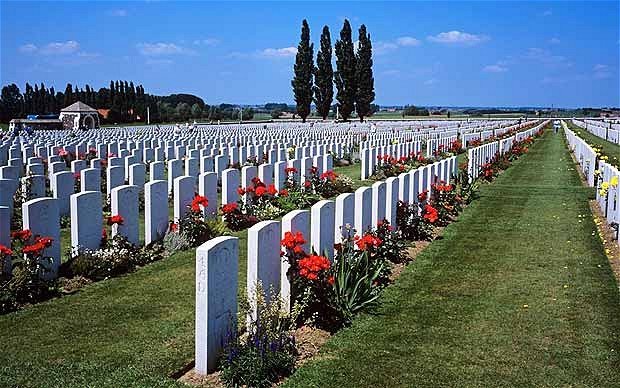
As soon as the war broke out in early August 1914, both British and the French were mobilizing their respective empires. Soldiers and labourers from all over the world were brought to the Western Front. More than 30 different nationalities were engaged in the Ypres Salient.
We must not forget that it is very difficult to define a nationality. For instance, Belgian includes Walloons and Flemings, French includes Bretons, Occitans and Flemings, who were often unable to speak or understand French. The British includes of course, English, Scots, Welsh, Irish, Channel Islanders, and I might have even forgotten some.
I'll just mention some nationalities apart from the main warring nation such as the British, German, French and Belgians. At a later stage in the war there were Americans and Portuguese troops. Further on there were Danes and Poles in the German army, as well as Russian and Italian P.O.Ws who were forced to work on the roads for the Germans. In the French Army, one would find Moroccan, Algerian, Tunisian, Senegalese, other West Africans, and troops from French Guyana as well as laborers from Indochina - the Ammonites.
The British, however, undoubtedly disposed of the world's greatest empire in 1914. Firstly, there were the Dominions; Canada, Australia, New Zealand and South Africa in addition to the crown colonies of Newfoundland and, of course, our main subject today - Sikhs from British India. It is quite obvious that even here a uniform sense of nation remained blatantly absent.
The New Zealand contingent counted a Maori pioneer battalion amongst their ranks. The CEF boasted both French-speaking Canadians as well as native Americans, often deployed as scouts. Some units were comprised exclusively of Japanese troops. The South African Expeditionary Force consisted of white soldiers (in the brigade) and separate black labour units such as the Cape Colored Labor Battalion, and the South African Native Labor Corps.
The then troops of the British Indian army or British Indian Labor Corps would, in our present day and age, be hailing from India, Pakistan, Bangladesh, Burma or Nepal. Even some smaller constituent parts of the British Empire sent their sons to Flanders' fields, Egypt (Egyptian Labor Corps), BWI (the Caribbean and mainly Jamaica, Trinidad & Tobago and Barbados) and Bermuda, the Fiji Islands (Fijian Labor Corps). Then again, the British army itself counted amongst their ranks white Rhodesians.
The universally renowned coolies - the locals called them chinks - were, in fact, hired Chinese laborers who served in three armies - the British, the French and the American. There was even a Russian Labor Corps present in the British army. This enumeration is, without any doubt, incomplete. I have restricted the list to those nationalities whose presence in Flanders during the Great War is undeniably proven by evidence of written documents, testimonials or material and facts.
But let's get back to our main subject of this talk, the Sikhs in the British Indian army and its presence in the Ypres Salient. This means that I will hardly mention Neuve-Chapelle, the main British Indian sector on the Western Front. Though only 25 miles south of Ypres, Neuve-Chapelle is not part of the Ypres Salient. In fact, the British Indian Army Corps was only deployed twice in the Salient, but each time at very crucial moments, at the end of October 1914 during the 1st Battle of Ypres, and at the end of April 1915, during the 2nd Battle.
But first of all I need to give a short introduction on the British Indian army. The Indian army was organized in a similar way as the British army but there were some significant differences. First of all, it had its own military law. Secondly, in the British Indian Army a regiment equals a battalion, although there are some exceptions to this rule. This means, for instance, that the 15th Sikhs does not mean the 15th battalion of the Sikhs regiment, but the 15th regiment!
A British Indian infantry division was composed of three brigades with four battalions (after the battle of Neuve-Chapelle in April 1915, five battalions). One of these four battalions was British, among other reasons as an element of controlling the Indian troops. An British Indian battalion consisted in theory of 13 officers and 750 rank and file - less than its British counterpart.
In my story, only one division is involved - the Lahore Division - the other division of the Indian Army Corps was the Meerut Division. I give you the composition of the Lahore Division in October 1914:
Infantry
Ferozepore Brigade: 1st Connaught Rangers
57th Wilde's Rifles
9th Bhopal Infantry
129th Duke of Connaught's Own Baluchis
(April 1915: + 4th London)
Jullundur Brigade: 1st Manchesters
15th Ludhiana Sikhs
47th Sikhs
59th Scinde Rifles (Frontier Force)
(April 1915: - 15th Ludhiana Sikhs, + 4th Suffolks, + 40th Pathans)
Sirhind Brigade 1/ Highland Light Infantry
1/1st Gurkhas
1/4th Gurkhas
125th Napiers Rifles
(April 1915: + 4/(King's) Liverpool Regt, + 15th Ludhiana Sikhs)
Divisional Troops
Artillery
15th Lancers (Cureton's Multanis)
34th Sikh Pioneers
20th and 21st Companies Bombay Sappers and Miners
5th, 11th, 18th Brigades, RFA
109th Heavy Battery
Field Ambulances
7th & 8th Field Ambulance (British)
111th, 112th & 113th Field Ambulance (Indian)
There were ethnic mixed battalions, such as the 57th Wilde's Rifles (8 companies, of which 2 Sikhs, 2 Dogras, 2 Pathans, 2 Punjabi Muslims) and ethnic homogeneous battalions, such as the 47th Sikhs (only Sikhs). It was a clear policy of the British to ensure a spirit of competition between the different peoples. It is common knowledge that Sikhs and Gurkhas were considered to be martial races.
There were two types of officers, British and Indian with the British always commanding the Indian. The higher ranks had the same names as in the British army, but there were some specific ranks such as subadar major (cf major), subadar (cf captain) & jemadar (cf lieutenant - commanding a platoon).
At the level of the NCOs, Indian terms were used: havildar major (sergeant-major), havildar naik (corporal) and lance naik. A private was a sepoy. The cavalry had its own ranks such as risaldar (captain), woordie-major (Indian adjutant), kot daffadar (sergeant major) etc. A trooper was a sowar. It is also important to emphasise the very particular relationship that existed between the British officers, their Indian NCOs and the rank and file. The British officers did speak the local languages and the relationship towards the Indian troops they were commanding is best described as paternalistic. There are numerous accounts of mutual respect from the officers towards the Indians and vice versa.
The story of the British Indian army on the Western Front starts on 6th August 1914. On that day, the War Council asks the Indian government to send two infantry divisions and a cavalry brigade to Egypt. The divisions chosen were the Lahore and the Meerut Divisions, later followed by the Secunderabad Cavalry Brigade which together formed the Indian Army Corps.
On 27th August the British Government decides to send the Indian divisions to France in order to reinforce the B.E.F. that had recently been forced to withdraw after Mons. Meanwhile, the Lahore Division was already on its way to the front. Its new destination was Marseilles, where it arrived by the end of September.
On its way to France, the Lahore Division left one of its brigades near the Suez Canal, and, as some units of the Jullundur Brigade only left India by the end of September, it was only the Ferozopore Brigade that was at its full strength.
Marseilles must have been a colorful sight in those days as it was also the port where most of the French colonial troops arrived. The British officers compared the behavior of their troops with those of the Algerians, Moroccans, Tunisians and Senegalese. During the 14 months that the British Indian Corps stayed in Europe, Marseilles was the Indian base port. The Indian troops were enthusiastically received by the French population.
For the British Indian troops, Europe was a totally new and a strange experience. They did not understand the language and were not understood and their culture was completely different. The Indians and the French or the Belgians looked upon one another with strange eyes. Nevertheless, the Indians were well received by the French population.
From Marseilles the Indian troops went north, over Orleans. When the 47th Sikhs were moving up to the front, they were billeted in a large monastery near Saint-Omer on 20th October 1914 and were well received by the monks. However, the curious troops continually scrutinized the statues of the twelve apostles in the main corridor of the abbey. Finally, they accepted their British officers' explanation that these were images of Christian gurus!
On 22nd October 1914, the Ferozepore Brigade arrives in the "new-born" Ypres Salient. They are sent to the trenches between Hollebeke in the north and Messines in the south. The trenches were not an uninterrupted line then, but was more a series of loose trenches, without the complex system with saps, communication trenches etc. that we are to know later in the War.
The 1st Connaught Rangers - the British battalion that belonged to the Ferozepore Brigade - were the first to have their baptism of fire. The first Indian battalion that had to go into the firing line was the 57th Wilde's Rifles in the vicinity of Wijtschate - Oosttaverne.
Sepoys from that unit are depicted on a famous picture taken in front of Café 't Nieuw Staenijzer in Wijtschate around that date. The photographs are from the IWM. However, the caption in the IWM is wrong. It says that these are soldiers from the 129th Baluchis. The mistake is made again and again. Strangely enough, (as it is clearly readable) the shoulder badge of the sepoy in the front is "57" and not "129". No doubt the mistake was made because Khudadad Khan VC, belonged to the 129th Baluchis.
On that day, 22nd October 1914, we also see the first Indian war casualty of the Western Front; Naik Laturia of the 57th Wilde's Rifles, commemorated on the Menin Gate. The arrival of the Indian troops went on and on. Father Achiel Van Walleghem, priest of Dikkebus, writes in his war diary that, during the whole night of 22nd -23rd October, the Indian troops are brought in by London double decker buses.
According to Van Walleghem, it was also the first day that the War could be clearly heard in his village. The next day, on 23rd October, the 129th Baluchis entered the trenches at Hollebeke while the last battalion of the Ferozepore Brigade, the 9th Bhopal Infantry, was arriving. The Connaughts and the Wilde's Rifles were placed under command of the 1st British Cavalry Division, the Baluchis under command of the 2nd cavalry division. The rest of the Lahore Division, now without two of its three brigades, was deployed on the other side of the French border.
On 26th October, a grey and misty day, the troops of the British Indian army attacked the German trenches near Gapaard, a hamlet of Messines. It had rained the whole night and the trenches were full with mud and water. Remark: trenches were considered as being very temporary and thus they were no more than shallow ditches. As mentioned, there was not yet a continuous line of defense. Here and there were "big gaps" between the different positions through which it was easy for the enemy to infiltrate in the lines.
Above all, it was more difficult to distinguish an enemy trench from an old trench abandoned by their own troops. The result of the attack on 26th October 1914 was several hundred yards but as the initial position was by all means more favorable than the new line, the troops were withdrawn again to their first positions. This caused much incomprehension and even disenchantment among the Indian rank and file.
On 30th October, after a heavy initial bombardment, the Germans attacked the Indian troops from the ridge of the Zandvoorde. The Indian and British troops were by far in the minority, had little ammunition and sparse artillery support, so it was obvious that it would be very hard to stand to. Two companies of the 57th Wilde's Rifles withdrew to Messines, where they were dispersed in the streets of the town. There was one officer there to point out the direction of HQ in Wijtschate, but some got lost and arrived in Kemmel, some 2.5 miles wrong! Other units of the 57th Wilde's Rifles were also forced to withdraw. Thus, a Sikh company had to take a new position in the neighborhood of a battery near the mill east of the Wijtschate-Messines Road.
Another company did not get the order to withdraw as all means of communication were cut or lost. When the message finally came through, it was too late as they were completely surrounded by German troops. The Baluchis too, in the neighborhood of the chateau on the other side of the canal and the railway, had very difficult times when standing.
The battle raged on until the next day. After a bombardment that lasted the whole night, Messines was stormed by nine German battalions. They overwhelmed the trenches of the 57th Wilde's Rifles and many units of this battalion were literally annihilated. Jemadar Ram Singh was the only survivor of his platoon.
Another Sikh, Jemadar Kapur Singh, kept on fighting until everyone else was out of action, except for one wounded sepoy. As he did not want to surrender, he committed suicide with his last bullet. All British officers of the 57th Wilde's Rifles, present on this part of the front, were killed. On that same day 31st October 1914 in the vicinity of Hollebeke, the action took place for which, some months later, Khudadad Khan of the 129th Baluchis was going to be the first Indian to be awarded the Victoria Cross.
During the night of 30th-31st October, the Baluchis had lost a position near a farm because they were unable to discern German from French soldiers. So they saw too late that they were approached by Germans and not by the French, who were holding the line, to the left of them. Khudadad Khan belonged to the company operating one of the two machine guns of the battalion. He himself got heavily wounded during the fights later that day, but nevertheless kept on operating the only surviving machine gun. Just before, the other machine gun was lost through shrapnel fire, the British officer wounded and five men of the unit were killed. Finally, when the Germans were getting close, he destroyed his machine gun and pretended to be dead. During the following night, he crawled through the enemy lines and was able to rejoin his company.
The losses of the 57th Wilde's Rifles and the 129th Baluchis were great during the last two days of October 1914. The Wilde's Rifles lost 300 out of 750, the Baluchis had 240 men killed, wounded or taken as POWs.
During these events, the Jullundur Brigade was just on the other side of the border, in the vicinity of Neuve-Chapelle - soon to become the Indian sector. There too the British Indian troops were thrown into the firing line from upon arrival. From 29th October 1914, the complete Meerut Division did arrive there. But as I will limit my talk to the Ypres Salient, I will not focus on that.
Once again, I want to emphasize that the whole of the Lahore Division was not deployed during 1st Ypres. Battalions, half battalions and even companies, were separated and deployed separately in support of diverse British divisions. All this happened while the British Indian troops at least expected to stay together. On 29th October 1914, General Willcocks wrote in his diary:
Where is my Lahore Division? Sirhind Brigade: left in Egypt, Ferozopore Brigade: somewhere in the north, divided in three or four pieces, Jullundur Brigade: the Manchesters in the south with the 5th division, the 47th Sikhs half with the one or the other British division, for the other half somewhere else. The 59th and 15th Sikhs: in the trenches…
It is clear that this was not really favorable for the morale of the Indian rank and file....
Click the link below for part 2:
100 Year Anniversay: Sikhs in WW2 ~ Part 2
Sikh soldiers of 15th Sikh regiment ( Multan ) landed in Marseilles -
France on the 26th of September 1914 for the 1st time.
This year 2014 is being remembered as the arrivals of the Sikhs in Europe as well as the
year of the beginning of World War I. Also the Sikhs had their first action
against European country that is Germany on 26 October 1914 near
Hollebeke - Belgium where a Sikh Monument stands since 3rd of April 1999, built
by the City of Ieper and inagurated by Panj Piaras to mark the 3rd
Century of the birth of the Khalsa. That means these historical event are
being celebrated throughout the world and in Europe by the Sikhs and
Europeans together.
Governor of Flanders and Deputy Mayor of Ieper - Belgium releases "Sikhs in World War I"
Sikh History and World War I and II.
https://www.youtube.com/watch?
5 Sikh Monuments of WW I & II
World War I - Belgium
Hollebeke - Belgium on 03-04-1999
https://www.youtube.com/watch?
Wijtschate - Belgium on 09-11-2008
https://www.youtube.com/watch?
World War II - Italy
Forli - Italy on 13-08-2011
https://www.youtube.com/watch?
Marrade - Monte Cavallara, Italy on 19-05-2013
https://www.youtube.com/watch?
In
Novellara City on 25-04-2014, 3rd Monument of the Sikh Soldiers of WW2
was inaugurated by
World Sikh Shaheed Millitary Yaadgari Committee,
Italy and City of Novellara R,E.
